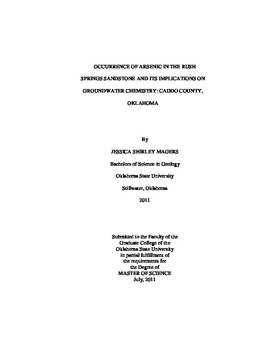| dc.contributor.advisor | Cruse, Anna M. | |
| dc.contributor.author | Magers, Jessica Shirley | |
| dc.date.accessioned | 2014-03-14T21:52:02Z | |
| dc.date.available | 2014-03-14T21:52:02Z | |
| dc.date.issued | 2011-07-01 | |
| dc.identifier.uri | https://hdl.handle.net/11244/8037 | |
| dc.description.abstract | Arsenic is considered highly toxic; ingestion causes toxic reactions ranging from skin lesions to cancer. Groundwater in some public supply wells within the Rush Springs Sandstone aquifer in Caddo County, Oklahoma contain arsenic concentrations that exceed the maximum contaminant level (MCL) of 10 μg/L established by the U.S. Environmental Protection Agency. The Rush Springs Sandstone is a Permian-;age redbed sandstone that outcrops in western Oklahoma. Iron oxide, which is prevalent in the Rush Springs Sandstone, has been associated with arsenic and its potential release into the groundwater system. To detect possible compounds that drive desorption, concentrations of metals and nonmetals were measured on three outcrops and three cores using a handheld x-ray fluorescence analyzer. Average arsenic concentrations in the Rush Springs Sandstone were 8.20 parts per million (ppm) in the cores and 7.62 ppm in the outcrops. These values fall into the upper range of background concentrations of arsenic in sandstone yet they are not remarkably high which is supported by the dissolved arsenic in the groundwater being above the MCL though still on the lower end 10.5-;18.7 μg/L. Compounds coming from the groundwater and interacting with the rock is likely controlling the arsenic release. The common fertilizer nutrient phosphorus has been linked to reactions such as this. A majority of Caddo County's water use is dedicated to irrigation of crops that would likely utilize these types of nutrients for farming. Introduction of competing adsorbents such as phosphorus could cause arsenic levels to increase in the groundwater and decrease in the rock. | |
| dc.format | application/pdf | |
| dc.language | en_US | |
| dc.publisher | Oklahoma State University | |
| dc.rights | Copyright is held by the author who has granted the Oklahoma State University Library the non-exclusive right to share this material in its institutional repository. Contact Digital Library Services at lib-dls@okstate.edu or 405-744-9161 for the permission policy on the use, reproduction or distribution of this material. | |
| dc.title | Occurrence of Arsenic in the Rush Springs Sandstone and Its Implications on Groundwater Chemistry: Caddo County, Oklahoma | |
| dc.type | text | |
| dc.contributor.committeeMember | Atekwana, Eliot Anong | |
| dc.contributor.committeeMember | Puckette, James L. | |
| osu.filename | Magers_okstate_0664M_11559.pdf | |
| osu.college | Arts and Sciences | |
| osu.accesstype | Open Access | |
| dc.description.department | Boone Pickens School of Geology | |
| dc.type.genre | Thesis | |
| dc.subject.keywords | arsenic | |
| dc.subject.keywords | oklahoma | |
| dc.subject.keywords | permian | |
| dc.subject.keywords | sandstone | |
| dc.subject.keywords | x-ray fluorescence | |
